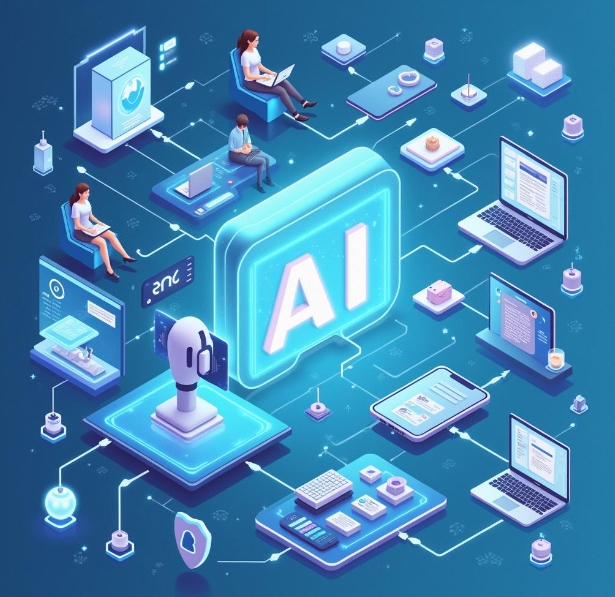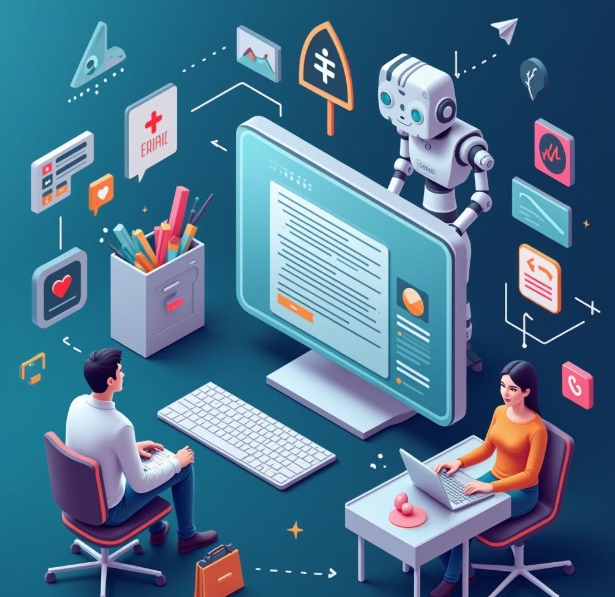Enterprise AI Chatbot Development: Pioneering a New Era of Intelligent Communication
- latest articles
- 1.DApp Development & Customization: Merging Diverse Market Needs with User Experience 2.Analysis of the Core Technical System in DApp Project Development 3.How to achieve cross-chain interoperability in Web3 projects? 4.How does the tokenization of points reconstruct the e-commerce ecosystem? 5.How to Set and Track Data Metrics for a Points Mall? 6.What is DApp Development? Core Concepts and Technical Analysis 7.Inventory of commonly used Web3 development tools and usage tips 8.Development of a Distribution System Integrated with Social E-commerce 9.Six Key Steps for Businesses to Build a Points Mall System 10.What is DApp Development? A Comprehensive Guide from Concept to Implementation
- Popular Articles
- 1.Future Trends and Technology Predictions for APP Development in 2025 2.Analysis of the DeFi Ecosystem: How Developers Can Participate in Decentralized Finance Innovation 3.From Zero to One: How PI Mall Revolutionizes the Traditional E-commerce Model 4.DAPP Development | Best Practices for Professional Customization and Rapid Launch 5.Recommended by the Web3 developer community: the most noteworthy forums and resources 6.From Cloud Computing to Computing Power Leasing: Building a Flexible and Scalable Computing Resource Platform 7.How to Develop a Successful Douyin Mini Program: Technical Architecture and Best Practices 8.Shared Bike System APP: The Convenient Choice in the Era of Smart Travel 9.How to Create a Successful Dating App: From Needs Analysis to User Experience Design 10.From Design to Development: The Complete Process of Bringing an APP Idea to Life
With the rapid development of artificial intelligence (AI) technology, businesses are encountering unprecedented opportunities to enhance work efficiency and improve customer experience. As a significant application within this field, AI chatbots are gradually becoming one of the core tools for corporate communication. Whether in customer service, marketing, information inquiries, internal management, or data analysis, intelligent chatbots have demonstrated immense potential and value.
I. AI Chatbots: Definition and Development
An AI Chatbot, as the name implies, is an automated tool that utilizes technologies such as Natural Language Processing (NLP), Machine Learning (ML), and Deep Learning to engage in intelligent conversations with users. Its core function lies in understanding and generating natural language to simulate human dialogue patterns, thereby helping businesses efficiently handle various user needs.
Initially, chatbots were only capable of simple, pre-set dialogues, answering common FAQs. However, with continuous technological advancements, particularly improvements in natural language processing capabilities, modern chatbots can conduct more complex and intelligent conversations, even achieving high levels of performance in areas like contextual understanding, sentiment analysis, and multi-turn dialogues. This enables businesses to utilize chatbots for automated communication across various scenarios.
II. Why Businesses Need to Develop AI Chatbots
1. Improve Efficiency, Reduce Costs
In traditional customer service, businesses often rely heavily on human agents to answer questions and handle services. This not only consumes significant human resources but can also lead to inefficiencies and human errors. AI chatbots, by automating customer requests, can respond to customer inquiries quickly and around the clock, significantly improving work efficiency. Furthermore, the chatbot's ability to handle common questions and simple tasks effectively reduces the workload of human agents, lowering the company's operational costs.
2. Enhance Customer Experience
Customer experience is a key factor in a business's success. As consumers increasingly demand instant responses and personalized services, businesses urgently need to find efficient and intelligent ways to meet these demands. Chatbots, with their 24/7 availability and instant response capabilities, can provide answers the moment a customer initiates a conversation. Moreover, through continuous learning, chatbots can offer personalized recommendations based on the customer's historical data and behavior patterns, further enhancing the customer experience.
3. Data Collection and Analysis
Chatbots are not just communication tools; they are also powerful instruments for data collection and analysis. Through interactions with customers, chatbots can automatically gather large amounts of customer information and feedback data. This data provides businesses with valuable market insights, helping them optimize products, improve services, and formulate precise marketing strategies. For instance, chatbots can identify shifts in customer needs and emotional tendencies, thereby assisting businesses in predicting market trends and user behavior.
4. Expand Marketing Channels
Modern chatbots not only provide basic customer service functions but also play a significant role in marketing and promotion. For example, many businesses use chatbots for promoting sales campaigns, product recommendations, online consultations, and other services, greatly expanding their marketing channels. Through interactions with customers, chatbots can implement intelligent sales funnel management, increase conversion rates, and help businesses identify potential leads.

III. Key Considerations for Businesses Developing AI Chatbots
1. Define Objectives and Application Scenarios
Before developing a chatbot, a business must first clearly define its objectives and application scenarios. Different scenarios require different functional capabilities from the chatbot. For instance, if the goal is customer service, the focus might be on answering common questions and handling after-sales issues. If the aim is market research, the emphasis might be on collecting customer feedback and understanding market demands. Therefore, businesses need to align with their specific needs, set clear goals, and ensure the developed chatbot effectively addresses real-world problems.
2. Choose the Right Technology Platform
Currently, there are many different AI chatbot development platforms on the market. Businesses need to select a suitable platform based on their technical capabilities and requirements. Some platforms offer complete solutions that enable businesses to quickly build and integrate chatbots, while others are more suitable for companies with technical teams, offering greater customization capabilities.
Simultaneously, choosing a platform that supports Natural Language Processing (NLP) and Machine Learning (ML) is crucial. These technologies allow the chatbot to understand user intent and provide intelligent responses based on context. For example, chatbots based on advanced algorithms like BERT or GPT can more accurately understand user needs during multi-turn conversations, delivering more human-like service.
3. Training and Optimization
Developing a chatbot is not just a technical setup process; it is more of a continuous cycle of training and optimization. In the initial stages, a chatbot might only handle simple scenarios. As dialogue data accumulates, it can gradually adapt to more complex tasks. Businesses can adjust and optimize the bot's responses through manual intervention and data analysis, ensuring its efficiency and accuracy in practical applications.
4. Cross-Channel Integration
With technological advancements, an increasing number of chatbots can be integrated across multiple platforms and channels. Businesses can integrate chatbots into their official websites, social media platforms, mobile applications, and other channels, ensuring customers can interact with the company anytime, anywhere. This multi-channel integration allows chatbots to achieve broader applications, enhancing the company's service coverage and customer reach.
IV. Future Development Trends of AI Chatbots
1. Deep Learning and Self-Evolution
With the continuous development of deep learning technologies, future chatbots will possess stronger self-learning and self-evolution capabilities. Through every interaction with users, chatbots will continuously accumulate experience, optimizing their language understanding and response strategies. This will enable chatbots to move beyond predefined response ranges and gradually develop the ability to handle complex problems.
2. Emotional Intelligence and Humanized Interaction
Currently, while most chatbots can understand basic user queries, there is still significant room for improvement in emotion recognition and humanized interaction. In the future, chatbots will be able to better understand users' emotional states through sentiment analysis technology, adjusting the tone and content of their replies accordingly. For example, when dealing with an angry or disappointed customer, a chatbot could proactively express empathy to alleviate user dissatisfaction, thereby improving customer satisfaction.
3. A New Era of Human-Machine Collaboration
AI chatbots are no longer just simple replacements for human service; instead, they are collaborating with human agents in many areas. For instance, chatbots can handle the majority of routine inquiries, while more complex issues or those requiring human empathy can be escalated to human agents. This human-machine collaboration model ensures both service efficiency and that users receive adequate care in complex situations.

V. Conclusion
As a vital tool for intelligent corporate communication, AI chatbots are creating unprecedented business value for companies. From improving efficiency and reducing costs to enhancing customer experience and expanding marketing channels, the widespread application of chatbots is undoubtedly transforming business operations. With continuous technological progress, future chatbots will become more intelligent and personalized, serving as a key driving force in corporate digital transformation.
When developing and using chatbots, businesses need to deeply understand their core functions, align them with actual business needs, select appropriate technology platforms and application scenarios, and continuously optimize and iterate. As intelligent communication becomes more prevalent, businesses will be better equipped to meet customer demands, stand out in the fierce market competition, and welcome the arrival of the new intelligent era.
-

How does artificial intelligence technology transform the operational models of modern enterprises?
In the wave of the digital era, artificial intelligence (AI) technology has tran···
-

How to Utilize Artificial Intelligence for Precision Medicine and Health Management
With the rapid advancement of technology, artificial intelligence (AI) has demon···
-

Integration and Application of Artificial Intelligence and Robotics
In today's era of rapid technological advancement, the integration of artificial···

 Blockchain
Blockchain










